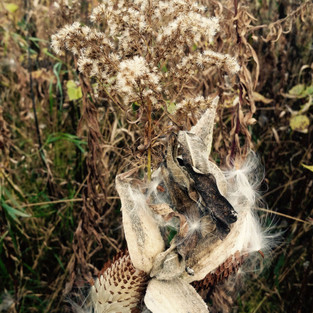Asclepias (milkweed) produces one of the most complex flowers in the plant kingdom. The plant’s highly-specialized flower structure and pollination technique is comparable to that of orchids.

Each flower contains structural patterns of fives (five petals that grow and reflex backward, five parallel ones that grow vertically, a five cup-like hoods, five horns, a five-membered corona, five stigmatic chambers, etc.). There are also five slits in each flower, each of which contain a golden sac of hundreds of pollen grains. These sacs are called pollinia. Rather than producing a sticky yellow dust, these pollinia mechanically attach to the insect’s feet when they step into a slit. Should the insect not be strong enough to pull the pollinia free when it flies from the flower, it may become trapped. Honeybees, especially, do not have the flight power to carry the sac and will die, still attached to the flower.
I found myself in a field of milkweed last weekend. Not every flower produces a pod, in fact, only 1 in 60 umbels (groupings of flowers) will produce a fuzzy seed globe. As these pods ripen, the convex seam of the fruit will begin to widen and release the brown seeds. The white silk tail on each seed is called the coma and is delicately carried by the wind.
It’s beautiful. The pods look dead, but really they are ripening, and the seeds inside are ready to travel and take root. I was awestruck by the art of it all. The very abstract mystery of structure vs. function vs. environment vs. destination baffles me.
As I explored the milkweed patch, I got one of my favorite ideas stuck in my head:
And the time came when the risk to remain tight in a bud was more painful than the risk it took to blossom.— Elizabeth Appell
I’ve probably written this quote in every one of my journals because I think it is both wise and convicting. It’s a lot easier to think of risk as ‘going out on a limb’ or doing something ‘out of your comfort zone’ – those kind of buzzwords.
That is one genre of risk. I’d go so far as to argue that those are examples of entry-level risk. Try taking public transportation for the first time or camping alone. Eat raw fish or rock climb. It is interfering with your normal routine and emotional equilibrium, sure, but truly very little is at stake.
An initial read seems counterintuitive: isn’t it opening up to new things that is the risk? Doesn’t the tight bud represent defensiveness and reactivity?

I believe there is another kind of risk. The risk that Appell is talking about is the risk of immutability: the risk of not growing.
What is at stake?
Like the asclepias flower, I believe that answer is highly-specialized and tailored to each of us. The answer is an internal, fertile seed.
For some, the risk is to be known, to be loved deeply, maybe to become unashamed. At some point, hiding truths and holding grudges – denying reality of any kind – becomes very painful, unbearable. The thing at risk is _______. You fill in your blank. The more often you misplace your identity, the harder it becomes to find.
Not only does the tight bud refuse to accept the full expression it is capable of, but nothing goes in or comes out. The life cycle abruptly ends. In a sense, it risks nothing. Ironically, I believe Appell suggests that might be the biggest risk of them all. Look at the odds.
I see the risk as apathy. The tight bud remains unaffected and suffers permanent loss, even forgetting youthful values and tenets. In staying tightly sealed, we leave all our great complexity and design to shrivel and rot. We forfeit the existence of what we have to offer, which just might be the nectar which sustains and nourishes other life.
Opening may also trap some honeybees. Life is not ever all-good or all-bad, and we are included in that. Existence does just that: it exists. It combines all of these factors and makes art.
The risk is to regret, 20 years later, what should have blossomed.






Comments